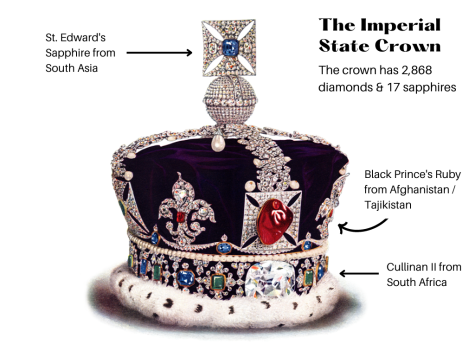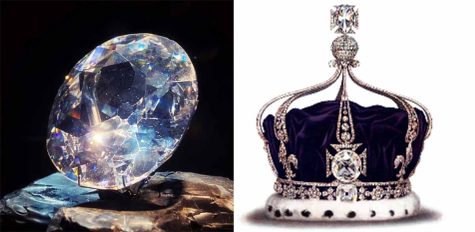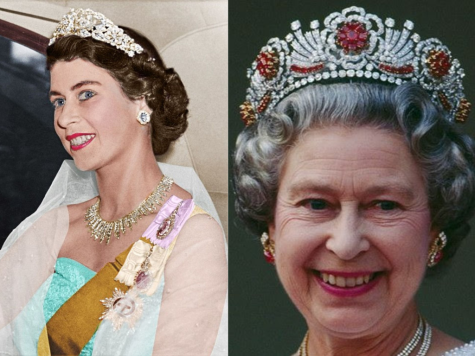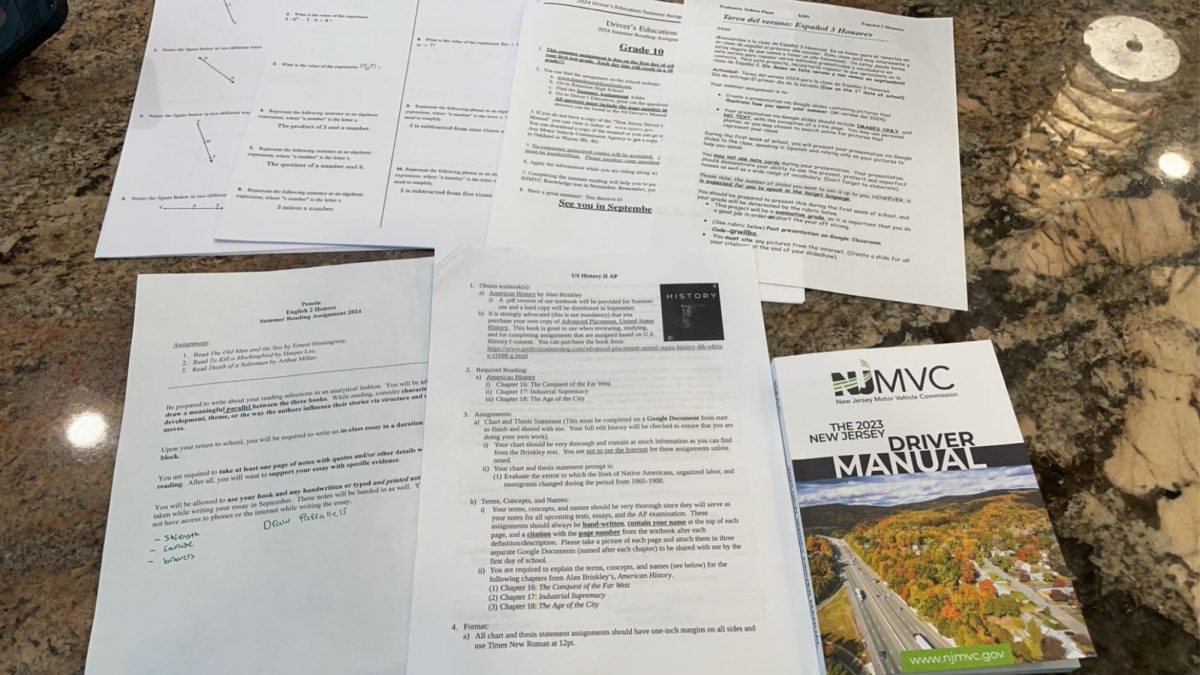The Tower of London is one of the oldest monuments in the U.K. Built during the 1070s, it’s a historical example of the European style of Gothic architecture of the High and Late middle ages. The lush green lawns, staggering battlements, and the giant medieval gates overlooking the River Thames make the monument look straight out of a fairytale.
However, the walls of the ancient building hold the world’s most famous relics, stolen through the British monarchy’s bloodied conquests and centuries of pillaging.
Following Queen Elizabeth’s death, many speculate about who will own the elaborate jewelry collection and if the Royal Family will return their stolen gemstones.
History teacher Danielle Elia says, “The British empire expanded into every time zone around the globe.” At its peak, the empire possessed 57 colonies, dominions, territories, or protectorates in places like Australia, Canada, India, Tonga, Fiji, and Samoa, according to Politico Magazine.
The British Empire used their colonies for their personal economic growth; with the production of goods, cheap labor, paying off debt, and building new communities. This is most prevalent in the 13 colonies of North America, which were built and maintained by the British. Compared to the kingdoms of India and many nations in Africa, which had centuries-old civilizations that were conquered and occupied by the British.
Through their conquests, the British often took spoils of war, or valuable pieces, from the countries they pillaged. These artifacts are still sitting in museums in the U.K. and even on the Royal Crown. Here are the most famous stones and jewelry that are currently in possession of the United Kingdom.

Great Star of Africa
The Great Star of Africa hails from South Africa. When the British Royal Family received the diamond in 1907, weighing 3,106.75 carats, they cut it into several stones. The largest piece, known as the Cullinan I, is currently the centerpiece of the royal scepter and is the second-largest diamond in the world.
During the Age of Exploration beginning in the early 15th century, South Africa proved to be an ideal spot for Europeans to carry out their economic ventures. From 1850-1910, the British colonized South Africa to service and restock ships on their way to India and the Far East. In the 1820s, South Africa saw the expansion of the Zulu Kingdom, which resulted in many military conflicts in the country. The Empire reached its end after the 1879 Anglo-Zulu War which helped strengthen British control in South Africa.
South Africa finally became part of the British Empire after the South African War at the end of the 19th century which ended with the Treaty of Vereeniging in May 1902. The different regions combined to form the Union of South Africa by 1910 and were fully under the control of the British. During this time, the Great Star of Africa was given to the Royal Family by South Africa’s colonial officials under Britain’s control.

Kohinoor
Stolen during Great Britain’s occupation of India that lasted approximately from 1858-1947, the Kohinoor originated from Punjab, India. The diamond weighs 105.602 carats and was found in the Kollur Mine in the 13th century. It’s currently embedded in the center of the Queen Mother’s Crown.
After the Second Anglo-Sikh War, a conflict between the Sikh empire and the British East India Company, 10-year-old king Duleep Singh gave the Kohinoor to Lord Dalhousie in accordance with the Treaty of Lahore in 1849. After the deaths of his father and brother, Duleep Singh had risen to power at the age of five, and his mother, Jind Kaur, acted as his regent. Due to her son’s young age, Queen Jind Kaur took control of the empire.
After the Sikhs lost the First Anglo-Sikh War, Jind Kaur was replaced by a Council of Regency under the British, but her power and influence prevailed, which led her to be imprisoned and exiled.
Following the end of the Second Anglo-Sikh War and the annexation of Punjab in March 1849, 10-year-old Duleep Singh with no parents or political power was removed from his position as king and put into the care of army surgeon Sir John Spencer Login in Uttar Pradesh, India. There he was converted to Christianity and taught about English society. He was then exiled to Britain and could only return to India a few times in his life due to the strict supervision of the British government.
Black Prince’s Ruby
Sitting above the Cullinan I on the Imperial State Crown, the Black Prince’s Ruby is believed to be from the Badakhshan mines in present-day Afghanistan and Tajikistan discovered in the Middle Ages. While it’s described as ruby, the gemstone is a red spinel weighing 170 carats.
The stone is known as “the great impostor” for its deceitful likeness to ruby and believed to be cursed. The gemstone made its first appearance in the 14th century as the jewel of Abu Said, the last Sultan of Granada, Spain. Granada was losing land to King Pedro the Cruel of the Christian Kingdom of Castile, so the Sultan arranged a peace meeting with the King. Upon his arrival, the Sultan and his servants were murdered by King Pedro, and the stone was taken off his body, beginning what was famously known as the “Sultan’s Curse.”
After King Pedro gave the stone to Edward the Black Prince of England, it caused the death of a long line of British kings, either from mysterious illness or misfortune in battle. After Charles I was executed in the Civil War and the Crown Jewels were sold off, the Black Prince’s Ruby would be refashioned as the crowning jewel of the Imperial State Crown in 1660.

Burmese Ruby Crown
The Burmese Ruby Crown was a personal commission made by Queen Elizabeth made with 96 rubies from the people of Burma, now Myanmar. It was first the Nizam of Hyderabad tiara, a wedding gift to Queen Elizabeth, then Princess, by the ruling Nizams. It was then dismantled and remade by Garrad in 1973 to make the current ruby and diamond crown.
Burma lies between India and China, with a dense population and vast amounts of natural resources. Mineral materials like tin, tungsten, jade, and rubies, and other resources like petroleum and rice were plentiful in Burma. The conflict began between the British and Burma when the Konbaung dynasty decided to expand into Assam, a state in British India. In the First Anglo-Burmese War from 1824-1826, Burma was forced to cede Assam and other northern provinces.
The Third Anglo-Burmese War in 1885 was provoked by the British and justified that the last independent king of Burma, Thibaw Min, was a tyrant conspiring to give France more influence in the country. The war lasted less than two weeks, and the British were able to enter the city of Mandalay. A few years later, the British occupied all of present-day Myanmar, making the territory a province of British India in January 1886.

Current News
In August 2022, the Horniman Museum and Gardens agreed to return 72 stolen artifacts after receiving a request from the Nigerian government. These artifacts include several sculptures known as the Benin Bronzes, totaling 5,000 bronze sculptures from the former Kingdom of Benin in present-day Nigeria, that were taken by the British Empire in 1897.
However, the Royal Crown hasn’t returned any of the more priceless gems. India’s first demand for the Kohinoor’s return was when it gained independence in 1947, then in 1953, 1997, and even more recently.
Being the centerpiece of the Royal Crown, many have doubts about whether the Kohinoor will be returned or not. But based on recent actions of British museums, there could be hope for the historical diamond to finally return home after more than 170 years.









